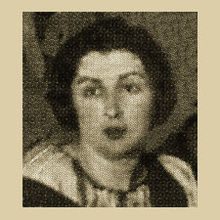Eva Pavlovna Levina-Rosewood
Eva Pavlovna rosewood , married Levina Rosewood , even Rosewood Levina , ( Russian Ева Павловна Розенгольц, Левина-Розенгольц, Розенгольц-Левина ; born May 29 jul. / 10. June 1898 greg. In Vitebsk ; † 18th August 1975 in Moscow ) was a Russian painter and graphic artist .
Life
Rosenholz, daughter of the Jewish merchant Pawel (Faiwel) Nachimowitsch Rosenholz and his wife Ziwja Abramovna, née Frumson, attended the Alexander Gymnasium in Vitebsk when she graduated in 1914. During the First World War she was a merciful sister in a hospital . In 1917 she was awarded by the University of Tomsk , the dentist diploma. 1917–1918 she lived in Moscow and took private drawing and sculpture lessons with Stepan Dmitrijewitsch Ersja . After the October Revolution , she returned to Vitebsk in 1919 when the Russian Civil War began .
In 1920 Rosenholz came back to Moscow and continued her artistic training in Anna Semjonovna Golubkina's studio . At the same time she began her studies in the higher artistic-technical workshops in the workshop of Robert Rafailowitsch Falks , which she graduated in 1925 with the title artist and the right to travel abroad. 1923–1931 she was married to the writer Boris Mikhailovich Levin (1899–1940) from Vitebsk.
Rosenholz exhibited her work at the Exhibition of the Society of Moscow Painters and at the Belarusian Art Exhibition in Minsk . In 1926 she traveled to France and England . 1927–1928 she took part in the exhibitions of the ROSTA news agency and the Association of Art Activists in Moscow. In 1929 she began studying the higher education courses at the higher artistic-technical institute in Moscow. From 1932 she worked as an artist for fabric painting in the Dorogomilowo factory. In 1934 she became a senior consultant for textile design at the People's Commissariat for Light Engineering in Moscow. Her main focus was pastel painting . In 1937 she took part in the interior design of the Soviet pavilion at the Paris World Exhibition in 1937 . At the beginning of the German-Soviet war she was evacuated to Tschistopol . In 1942 she returned to Moscow.
In August 1949, Rosewood was arrested as part of the campaign against the rootless cosmopolitan and sentenced by the Ministry of State Security of the USSR to 10 years in exile in the Krasnoyarsk Territory . There she was a lumberjack, painter , barge labeler and nurse. 1954–1956 she worked in Karaganda as a set designer in the Kazakh Dramaturgical Theater .
In 1956, rosewood was rehabilitated, after which she returned to Moscow. She now dealt exclusively with graphics , preferring ink drawings with a brush or pen, but also pastel painting. She created a series of picture cycles. The Pushkin Museum now has the largest collection of her drawings . The Tretyakov Gallery also presents its works, as do many Russian and foreign private collections.
Rosenholz 'older brother was the People's Commissar Arkadi Pavlovich Rosenholz . Her cousin was the poet Jelena Michailowna Schirmann .
Web links
- Literature by and about Eva Pawlowna Levina-Rosenholz in the bibliographic database WorldCat
- Catalog of the Russian National Library : Левина-Розенгольц, Ева Павловна
Individual evidence
- ↑ a b c d e РОССИЙСКИЙ ГОСУДАРСТВЕННЫЙ АРХИВ ЛИТЕРАТУРЫ И ИСКУССТВА: Розенгольц-Левина Ева Павловна (accessed October 26, 2019).
- ↑ a b c d Women in World History: A Biographical Encyclopedia: Rozengolts-Levina, Eva (1898–1975) (accessed October 25, 2019).
- ↑ Erik Bulatov, J. Afferica: Eva Levina-Rozengolts: Her Life and Work . National Museum of Women in the Arts, 1999, ISBN 0-940979-40-3 .
- ^ The Museum of Russian Art: Eva Levina-Rozengolts: Reflections on a Siberian Exile (accessed October 25, 2019).
- ↑ artnet: Eva Levina-Rozengolts (Russian, 1898–1975) (accessed October 25, 2019).
| personal data | |
|---|---|
| SURNAME | Levina-Rosenholz, Eva Pavlovna |
| ALTERNATIVE NAMES | Rosenholz-Levina, Eva Pavlovna; Левина-Розенгольц, Ева Павловна; Розенгольц-Левина, Ева Павловна (Russian) |
| BRIEF DESCRIPTION | Russian painter and graphic artist |
| DATE OF BIRTH | June 10, 1898 |
| PLACE OF BIRTH | Vitebsk |
| DATE OF DEATH | 18th August 1975 |
| Place of death | Moscow |
